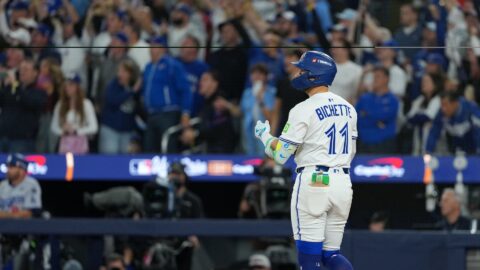The Red Sox finally got their ace, but is that going to be enough to keep Boston in the playoff race?
Yes, it’s come to this. The majority of the 2015 season was spent wondering what the Red Sox would be if only they had a clear No. 1 starter, and now we’re wondering if adding that type of pitcher is all it’ll take for Boston to return to the postseason. It’s not an unfair question.
Make no mistake, getting David Price to Boston on a seven-year, $217 million contract was huge. The left-hander has been consistently good since his first All-Star season in 2010, and he also has tons of experience in the AL East, having played for the Tampa Bay Rays for the first seven seasons of his career and for the Toronto Blue Jays for the second half of 2015.
FanGraphs projects the 2012 American League Cy Young winner will finish 2016 with a 2.95 ERA and 219 strikeouts over 215 innings and 32 starts. But Price can’t win all of those starts. The guys behind him in the rotation will need to pull their weight.
In reality, the viability of Boston’s rotation hinges largely on Clay Buchholz, and not Price. Price isn’t showing any signs of regression, so barring a serious injury, that No. 1 spot is safe. Buchholz likely will be the No. 2 starter, and he has seriously struggled to stay healthy.
Buchholz has gotten through only one of his nine Major League Baseball seasons without hitting the disabled list, and the Red Sox’s rotation isn’t necessarily deep enough to handle the right-hander missing significant time in 2016. It’ll be important for Buchholz to take the ball every fifth day, because when the two-time All-Star is on his game, he really can perform.
The good news for the Red Sox is that between landing Price and lengthening out their bullpen with the additions of Craig Kimbrel and Carson Smith, there likely will be less pressure on Buchholz to try to be a star this season.
Behind Buchholz, it gets iffier, though that doesn’t necessarily mean bad things are on the horizon. Nos. 3 through 5 in Boston’s rotation likely will be some combination of Eduardo Rodriguez, Rick Porcello and Joe Kelly, and there are some questions surrounding each for 2016.
To start, Porcello and Kelly had rough 2015 seasons. Both finished with ERAs just below 5.00 — Porcello’s was 4.92 and Kelly’s was 4.82 — and struggled to find any type of consistency, though it’s worth noting that both pulled it together at the end of the season.
Porcello had a 3.14 ERA after returning from the DL on Aug. 26. He allowed two runs or fewer in five of his final nine starts. Kelly, meanwhile, wound up on the DL to end the season after injuring himself on Sept. 15, but he did post a 2.35 ERA in his final eight starts.
As for Rodriguez, this season could help define the 22-year-old lefty. Although he didn’t put up crazy numbers in 2015, he showed major league poise in his rookie season. His control and composure was pretty astounding for a pitcher as young as he is, and he still came out with a 10-6 record and a 3.85 ERA while pitching on an innings limit. If he’s gotten over tipping pitches, we could see big things from Rodriguez in 2016.
Basically, on paper, the Red Sox could be just fine with Price and the four others mentioned. If anything, Price’s presence takes pressure off everyone else to be the “ace,” and each pitcher can focus on doing his own thing. The Sox also could be surprised by minor leaguers Henry Owens and Brian Johnson if they’re ever in need of some depth.
Sure, the Red Sox were projected to get by on a rotation full of ground ball pitchers in 2015 — a strategy that didn’t work — but that was a much riskier venture. Boston’s current situation isn’t perfect, but it’s much, much better with Price around.
Thumbnail photo via Twitter/@RedSox



